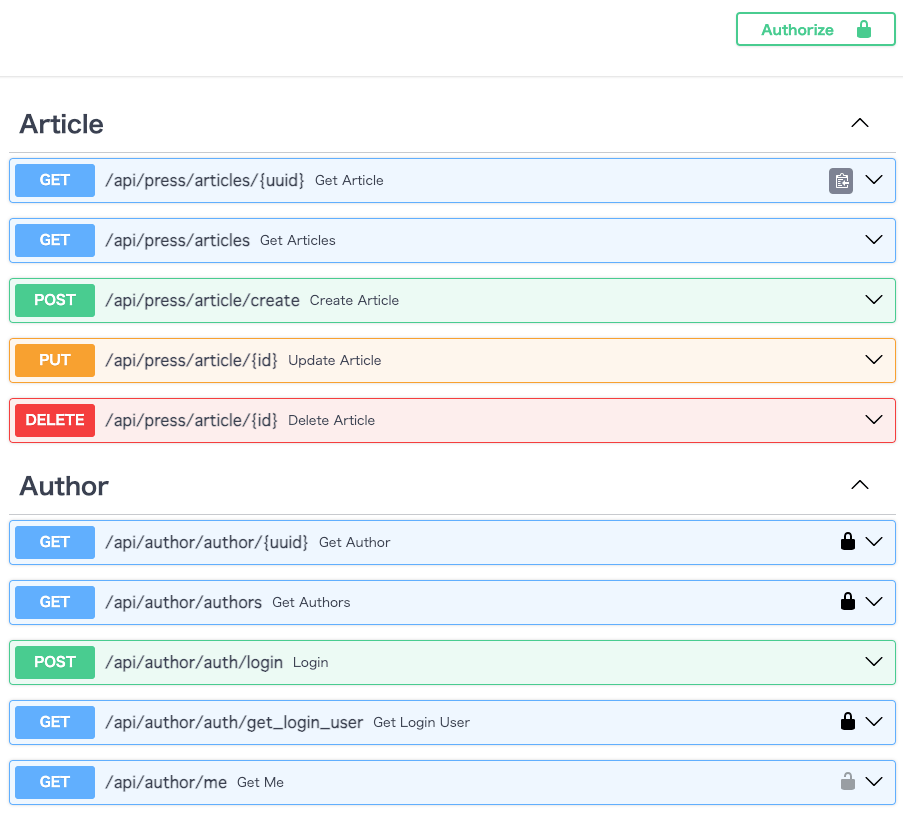Django Ninjaで認証機能を追加
前回まではDjango Ninjaで基本的なCRUDを実装してきましたが、今回は認証機能を実装していきます。
※前回までの記事はこちら※
スキーマの設定
schemaは前回までに作成したCustomUserモデルをベースに作成し、後から利用するTokenに関するschemaも設定しておきます。
CustomUserの設定はこちらの記事を参照してください。
コードはこちら
from .models import CustomUser
from ninja import ModelSchema, Schema
class CustomUserSchema(ModelSchema):
class Meta:
model = CustomUser
exclude = ['password', 'last_login', 'birth_date']
class CustomUserOut(ModelSchema):
class Meta:
model = CustomUser
fields = ['uuid', 'username', 'email', 'first_name', 'last_name']
class CreateCustomUser(Schema):
username: str
email: str
password: str
first_name: Optional[str]
last_name: Optional[str]
class UpdateUser(Schema):
username: Optional[str]
email: Optional[str]
first_name: Optional[str]
last_name: Optional[str]
is_active: Optional[bool]
is_staff: Optional[bool]
is_superuser: Optional[bool]
# token
class TokenSchema(Schema):
access_token: str
refresh_token: str
token_type: str
CustomUserSchemaは基本的なschemaとして設定しています。
そしてDjango Ninjaの最大のメリットである、Djangoモデルからschemaを生成をするため、ModelSchemaクラスを渡して、schemaを作成しています。
詳細は公式ドキュメントを参照してください。
ModelSchemaクラスを渡すことで、Djangoで設定したモデルとそのフィールドを利用してschemaを生成できます。
また、今回のCustomUserSchemaは、DjangoのモデルであるCustomUserを使用しているため、json形式で出力するときに含めたくないフィールドも含まれています。
そのため、json形式に含めたくない(=外部に出したくないフィールド)をexcludeに配列で指定し、json形式での出力からは除いています。
このようにすることで、不要なフィールドや外部に出したくないフィールドを制限することができます。
また、CustomUserOutのschemaでは、同じようにModelSchemaを渡して、Djangoのモデルからschemaを生成していますが、fieldsを指定し、json形式で返したいフィールドだけを指定しています。
ここでは、5つのフィールドのみを指定しています。
Tokenスキーマについては、この後使用するために3つのフィールドを設定しています。
これはDjnagoのモデルを使用しませんので、Schemaクラスを渡しています。
認証のための処理
次に、認証を行うための処理を書いていきます。
Django Ninjaでの認証は、以下の公式ドキュメントとChatGPTを参考に設定しました。
必ずしも正解というわけではありませんので、適宜最適な方法で実装してください。
それでは、認証に必要なクラスを設定していきます。
コードはこちら
from .models import CustomUser
from ninja.security import HttpBearer
from jose import jwt
class JWTBearer(HttpBearer):
def authenticate(self, request, token):
try:
# tokenを検証してペイロードを取得
payload = jwt.decode(
token,
os.environ['SECRET_KEY'],
algorithms = os.environ['ALGORITHM']
)
# uuidを取得してuserを取得
user = CustomUser.objects.get(uuid = payload['uuid'])
return user
except Exception as e:
return {
'status_code': 401,
'detail': 'トークンタイプが一致していません'
}
公式ドキュメントにあるHTTP Bearerを使用して設定しています。
また、python-joseを使用したjwtの処理を追記し、渡されたtokenをdecodeして、ユーザー取得のためuuidを取り出しています。
そして、このように設定したクラスをAPI作成時に、各APIにauth引数として渡すことで設定したAPIに認証を必須とすることができるようになります。
また、Routerにauth引数を渡すことで、routerに紐づくすべてのAPIに認証機能を設定することができます。
from .crud import JWTBearer
router = Router(auth = JWTBearer())

(上記の例はauthorに関するAPIに認証を必須としたものです)
tokenの生成
認証にはjwtを使用したtoken認証としていますので、これに必要なaccess_tokenとrefresh_tokenを作成していきます。
コードはこちら
from datetime import datetime, timedelta
from .models import CustomUser
from ninja.security import HttpBearer
from jose import jwt
import os
from dotenv import load_dotenv # add
load_dotenv()
def create_access_token(user):
# access_tokenの有効期限を3時間に設定
expire = datetime.now() + timedelta(hours = 3)
return encode_token(user, expire)
def create_refresh_token(user):
# refresh_tokenの有効期限を1週間に設定
expire = datetime.now() + timedelta(weeks = 1)
return encode_token(user, expire)
def encode_token(user, expire):
# JWTトークンのpayloadを設定
payload = {
'uuid':user.uuid,
'exp': expire
}
# JWTトークンを生成して返す
return jwt.encode(
payload,
os.environ['SECRET_KEY'],
algorithm = os.environ['ALGORITHM']
)
access_tokenの生成:create_access_token
refresh_tokenの生成:create_refresh_token
JWTtokenの生成:encode_token
としています。
APIの処理はこの後になりますが、ログインAPIを叩いた時に、userを取得することにするので、そのuserをこれらの関数に渡し、userからuuidを取り出し、tokenの生成に使用しています。
また、SECRET_KEYとALGORITHMは、使い回しができるようにかつ外部に漏れないように、.envファイルに記載しています。
なお、SECRET_KEYの生成は、以下のコマンドを実行します。
openssl rand -hex 32
これで生成されたSECRET_KEYを.envファイルに記録します。
APIの作成
それではAPIを作成していきます。
今回は、authorアプリケーション内に作成したapi.pyに書いていきAPIに原則認証が必要となるような設定にしていきます。
コードはこちら
from typing import List
from .models import CustomUser
from django.shortcuts import get_object_or_404
from django.contrib.auth import get_user
from ninja import Router
from .schemas import CustomUserOut, TokenSchema
from .crud import create_access_token, create_refresh_token, JWTBearer
router = Router(auth = JWTBearer())
@router.get('/author/{uuid}', response = CustomUserOut)
def get_author(request, uuid: str):
author = get_object_or_404(CustomUser, uuid = uuid)
return author
@router.get('/authors', response = List[CustomUserOut], auth = JWTBearer())
def get_authors(request):
authors = CustomUser.objects.all()
return authors
@router.post('/auth/login', response = TokenSchema, auth = None)
def login(request, email: str, password: str):
user = CustomUser.objects.get(email = email)
if user.check_password(password):
access_token = create_access_token(user)
refresh_token = create_refresh_token(user)
return {
'access_token': access_token,
'refresh_token': refresh_token,
'token_type': 'bearer'
}
else:
return {
'detail': 'Incorrect email or password'
}
@router.get('/auth/get_login_user', auth = JWTBearer())
def get_login_user(request):
login_user = get_user(request)
if login_user.is_authenticated:
return login_user
else:
return {
'detail': 'User not authenticated.'
}
ログインAPI
@router.post('/auth/login', response = TokenSchema, auth = None)
def login(request, email: str, password: str):
user = CustomUser.objects.get(email = email)
if user.check_password(password):
access_token = create_access_token(user)
refresh_token = create_refresh_token(user)
return {
'access_token': access_token,
'refresh_token': refresh_token,
'token_type': 'bearer'
}
else:
return {
'detail': 'Incorrect email or password'
}
ログイン用のAPIではresponseとしてtokenを返す(取得する)ようにしますので、response引数にTokenSchemaを指定しています。
また、上記のとおり、ログイン用のAPIに関しては認証を不要とするので、auth引数にはNoneを指定し、認証を適用していません。
一方、routerではauthに先ほど書いたJWTBearerを指定していますので、ログイン用のAPI以外には、個別にauth引数を指定しなくても、基本的に認証が必要な設定となります。
処理の流れとしては、
- emailとpasswordを受け取りログイン処理をする
- ログインはemailに紐づくデータをCustomUserモデルから取得している
- userのpasswordをチェック(Djangoにデフォルトであるcheck_passwordを使用)し、問題なければ、access_tokenとrefresh_token、token_typeを返す
- passwordのチェックが通らなければ、emailまたはpasswordに誤りがあることを通知してる
という流れです。
authorの取得
authorの取得は、6種類用意しました。
(R6.4.1:post, put, deleteメソッドを追加しました)
コードはこちら
@router.get('/author/{uuid}', response = CustomUserOut)
def get_author(request, uuid: str):
author = get_object_or_404(CustomUser, uuid = uuid)
return author
@router.get('/authors', response = List[CustomUserOut])
def get_authors(request):
authors = CustomUser.objects.all()
return authors
@router.get('/auth/get_login_user', response = CustomUserOut)
def get_login_user(request: HttpRequest):
login_user = request.auth
if login_user.is_authenticated:
return login_user
else:
return {
'detail': 'User not authenticated.'
}
@router.post('/create', response = CustomUserOut, auth = None)
def create_user(request, payload: CreateCustomUser):
if CustomUser.objects.filter(email = payload.email).exists():
return {
'message': 'Email is already used. Please change email address.'
}
if CustomUser.objects.filter(username = payload.username).exists():
return {
'message': 'Username is already used. Please other username set.'
}
user = CustomUser(
uuid = str(uuid.uuid4()) # uuidはデフォルトでuuid型になるためstrに変換
username = payload.username,
email = payload.email,
first_name = payload.first_name,
last_name = payload.last_name
)
user.set_password(payload.password)
user.save()
return user
@router.put('/author/{uuid}', response = CustomUserOut)
def update_author(request, uuid: str, payload: UpdateUser):
author = get_object_or_404(CustomUser, uuid = uuid)
for attr, value in payload.dict().items():
setattr(author, attr, value)
author.save()
return author
@router.delete('/author/{uuid}')
def delete_author(request, uuid: str):
author = get_object_or_404(CustomUser, uuid = uuid)
author.delete()
return {'message': 'success'}
いずれもGETメソッドなので特に難しいことはしていません。
認証が通ればauthorに関するデータを取得できるようにしています。
また、最後のget_login_userは、request.authを使用してログイン中のユーザーを取得しています(認証の確認はDjangoのis_authenticatedを使用)。
post, put, deleteはarticleで使用したAPIを流用しています。
このような画面になればOKです(画像は認証後のものです)。

最後に
Django Ninjaでログイン処理を実装してみました。
まだ、refresh_tokenを使用していないことと、authorの更新や削除などのauthorに関するCRUD処理を設定できていないのがまだまだといったところです(今後この記事を更新していく予定です)。
CRUD処理を作ったならば、その後はフロントエンド(Next.jsかSveltkitまたはhonoxを検討中)から実際に情報を送信して、データの取得ができるかも試してみたいと思っています。
Discussion
能更新一下author的CRUD操作么?